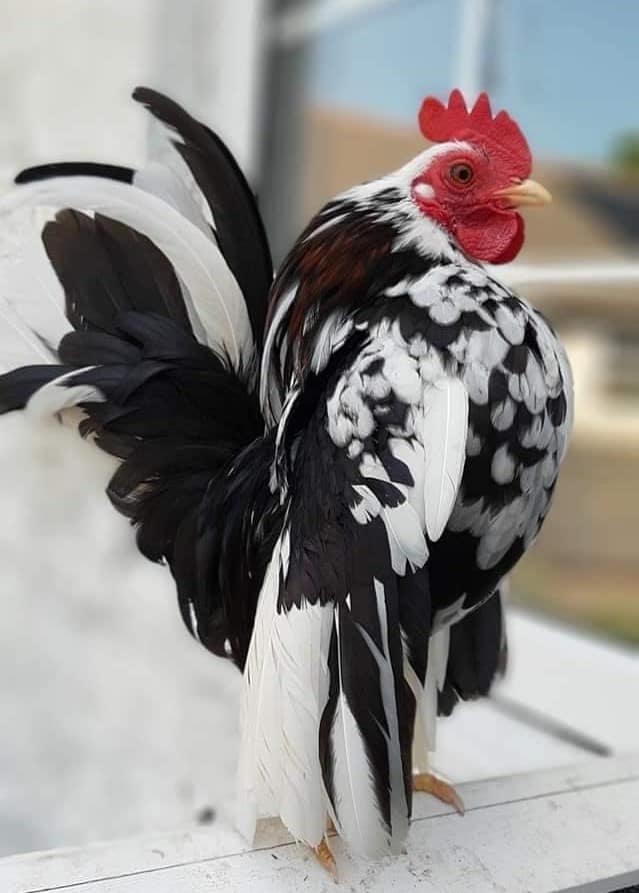Originating from Malaysia, the Serama chicken is a lovable breed that has sparked the interest of many in the western world. Their lovable nature and tiny size make desirable for chicken lovers.
Though their appearance may pull at your heartstrings, these little beauties can be quite costly. It’s the smallest chicken in the world and a true bantam breed. It’s important not to raise them in a mixed flock.
Let’s take a look at some facts and how to care for them before you decide to add them to your backyard farm.
Purpose for Raising
Serama chickens are used as an indoor or outdoor pet, for ornamental purposes, and for eggs. Chicken owners typically don’t choose them as a meat bird as they are small and have muscular bodies.
They are also used in a mission to help children with autism. The Serama Autism Project out of New York provides an emotional support Serama to act as a companion to help a child with communication, fine motor skills, etc.
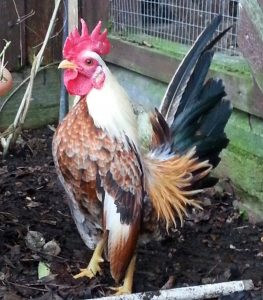
Serama Chicken
Seramas have a lot of history, dating as far back as the 1600s. They are known to be of Japanese and Malaysian origin and are a result of the breeding process done by Mr. Wee Een in 1970.
The crossbreed involved Japanese bantams and the local bantams of Malaysia. He named the breed ‘Serama’ after King Rama, a Thai king.
At that point, the birds became popular. Their population significantly decreased following some national crises, especially the Asian pandemic. They have, however, regained recognition and have become an accepted chicken breed.
Other names for Serama bantams include:
- Malaysian Ayam Serama chicken
- Ayam Serama
- Malaysian Serama
- Kikiriki chickens
The White American Serama and the AOV American Serama are classified as single comb, clean legged game bantams. For comparison, some other breeds in this group are the Barred Plymouth Rock, Buff Orpington, Speckled Sussex, and S.C. Rhode Island Red.
Physical Features
The first noticeable physical feature of the Serama chicken is their size. They are extremely small and short. Still, they stand out.
Standing around 6 – 10 inches tall, their body structure is very tiny. The Serama has long wings and tail feathers that mostly stand upright.
They usually maintain a rigid posture forming the letter ‘V’ with their chest puffed out. They are upright almost making them look like they might topple backwards.
The shoulders and legs of this breed are quite broad and muscular, with their back tight, leaving little or no space between the mass of feathers and the neck.
They have small heads which are always positioned high, making them look alert and confident. Seramas have a single comb which is red and white, red earlobes and eyes, and white or yellow skin.
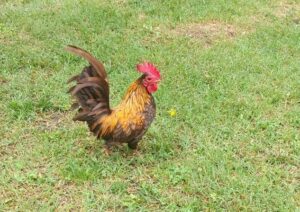
Color
Serama chickens can be a variety of colors. This is because breeders did not target their breeding program at color. Variations can include white, black, yellow, and orange, with sometimes a mixture of different color feathering.
They are striking birds with their layered, colorful plumage.
Serama Chicken Size
There is a standard size and weight for Serama chickens. As previously stated, they are quite small at no more than 10 inches.
Serama’s are classified according to their weight with only four accepted weights, which includes:
- Micro: Males up to 13 ounces, and females up to 8 ounces
- Class A: Males under 13 ounces and females under 12 ounces
- Class B: Males under 16 ounces; females under 15 ounces
- Class C: Males under 19 ounces; females under 19 ounces
Personality
People term many birds as “proud,” and the Serama chicken is one of them. These little gems have an elegant poise which is because of their structure.
The Serama’s posture gives them a defensive look which is the opposite of their personality. They are friendly and loving backyard chicken and roosters.
Serama chickens are one of the best chicken breeds as a pet because they are cuddly, and their small size makes them easy to handle and carry around. Seramas enjoy being around people and love to interact with them.
They are active creatures and are usually flying and foraging around the homestead or rural garden making them an asset for insect management.
They are lower in the pecking order due to their small size. Raising them with other bantams is ideal. Standards and Seramas don’t mix.
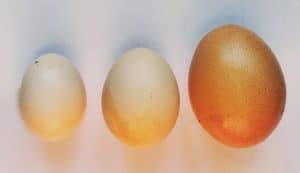
Eggs
Serama hens are excellent layers with a fast development stage. They are fertile birds that lay eggs all year round and can lay between 3 – 5 eggs per week.
Hens will start laying when they are 4 – 5 months old. Though they are great layers, there are individual differences in the number and sizes of eggs.
Like quail eggs, Serama chicken eggs are relatively small. Four or five of these eggs will equal a regular-sized egg. Their eggs also have different colors ranging from very dark or brown to cream and white eggs with varying shades of color in between.
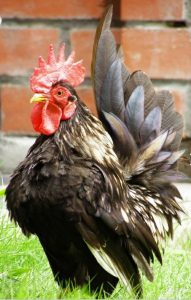
Serama Roosters
If you want to hatch fertile eggs or if you want to protect against predators, consider adding a Serama rooster to your flock. Be sure to keep the hen-to-rooster ratio to 8 – 10 hens per rooster.
It’s also essential that you keep roosters separated. Serama roosters tend to be territorial and aggressive toward each other, so keeping them in different enclosures will ensure their safety and comfort.
Roosters have many reasons for crowing. Some Serama roosters crow loudly, like full-sized roosters. Keep this in mind if you have neighbors close by.
Serama Chicks
Serama hens go broody and can hatch fertile eggs, adding to your flock. They’ll love sitting on their eggs. They have strong maternal instincts and make good mothers. If you have a hen who doesn’t, another broody hen such as a Silkie chicken will be happy to sit.
The concern is that Serama chicks are extremely small. Keep larger, aggressive breeds away from them.
Also, when considering the best chicken feed options, you’ll need to feed a Serama chick differently than chicks from other breeds. You can grind their chick crumbs in a blender or crush them some other way. Pellets are too big for chicks to eat.
Learn what to feed baby chickens after hatching to ensure their nutritional requirements are met.
Serama Chicken Care
Raising Serama chickens can be excellent addition to your farm family. However, it’s essential that you provide them with the proper care they need.
Ensuring that you set up the right living conditions, feed them a nutritious diet, and give them lots of love can help optimize the health of Serama hens and Serama roosters.
Let’s take a look at a few of the conditions in which your Serama will thrive.
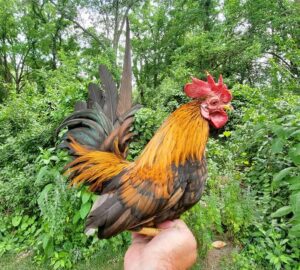
Living Conditions
Serama chickens are very fragile due to their small stature. They have little to no tolerance for harsh environmental conditions, especially cold and drafty temperatures. They do better in warmer climates.
A temperature below 40°F will be too cold for Seramas to survive. Extreme cold can affect their egg production rate, their activeness, and their overall health.
Most Serama chicken owners keep them in draft-free enclosures during colder temperatures to ensure they remain warm and dry. Due to their size, they won’t require a large or expensive enclosure, so setting one up on your property shouldn’t be too costly. Find a good chicken coop that’s secure and comfortable for them.
On the contrary, during warmer conditions, Serama chickens enjoy roaming and foraging for their food. They will be content with an area that is grass-based as they don’t prefer muddy or wet surfaces.
They can make due with smaller spaces, similar to a bantam chicken. When considering how much space chickens need, Seramas require a minimum of two square feet each. More is even better.
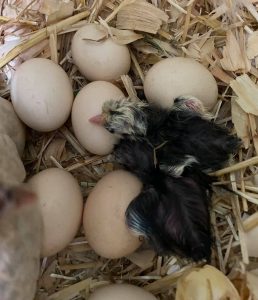
Feeding
Raising Serama chickens is cost effective, and you get a good return on investment. They don’t eat much. In fact, they will only consume about one pound of food each month.
Because of their size, it’s advisable to include a large percentage of nutritious crumble feeds in their feeding plan. Even the fully-grown Seramas can’t eat pellets. Feed them crumbles or mash instead.
They’ll also need clean fresh water daily. It’s best to have several watering systems for them to minimize fighting for the favorite. Installing small waters, such as those designed for raising quail, will help ensure they can access water easily.
Health Issues
Serena chickens are generally healthy, but some strains usually inherit a deadly gene from the Japanese bantams. This gene affects them even from inside the egg.
A large percentage of them die before they hatch because they have shorter legs, preventing them from completing the hatching process.
The birds are also a target of ectoparasites like ticks and lice, which may slow them down because of their small size. You must constantly inspect them and schedule regular medical checkups to ensure they are well and healthy.
How Long Do Serama Chickens Live
A Serama chicken lifespan will depend a lot on the care it receives. With proper food and living conditions, they live to be around 7 years old. They can also live longer, making them a viable family pet.
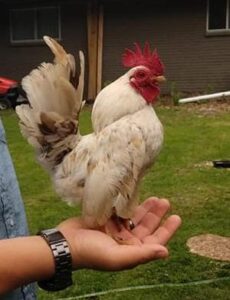
Serama Chickens For Sale
You can buy chicks and chickens from Serama chicken breeders. Being more expensive than an average chicken, a lot depends on their quality, age, and gender.
A reputable breeder will charge anywhere from $30 – $40+ for males to $30 – $70+ for females.
Depending on their bloodline, they can exceed $100 each. The females will typically always be more expensive than the males.
Pet quality Seramas can sell for $10 – $30. You can check on Craigslist.
Compare this price to other chicken breeds, and you will see how much more costly these tiny chickens are. However, having the world’s smallest chicken breed can be a fun adventure.
Chicken fanciers will enjoy raising them as an ornamental bird or as a pet instead of thinking about them as laying for homesteading. This may make them seem more affordable.
Also, if you buy a rooster along with hens from a Serama chicken breeder, you’ll be able to hatch fertile Serama eggs at home yourself.
Smallest Chicken Breed
Acquiring a Serama bantam chicken can be a great addition to your poultry family or backyard, especially if you don’t live in a cold climate. They aren’t cold hardy chickens.
While they may cost more than other types of chickens, they will be a productive pet with their eggs. Seramas are considered to be good layers providing eggs weekly.
They are lively and social birds. With a simple aviary constructed, they are content to play, lay tiny chicken eggs, and entertain you and your family. Some owners raise them truly as pets and keep one or two Seramas indoors as a house pet.
Here are my friend’s Belgian Bearded d’Anver bantams.
Learn about other interesting chickens:

